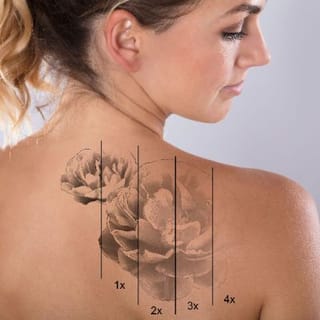 A tattoo is a permanent mark made by depositing ink or pigment into the skin. Various options are available for tattoo removal including: laser treatments, dermabrasion, chemical peels, and even surgical excision. Laser treatments are the preferred method for most tattoo removal. Laser therapy works by breaking the ink/pigment in the skin into smaller fragments which can then be removed by the immune system. Typically, multiple treatments are needed. Depending on the size and color, complete removal may not be possible, but treatments can help to significantly fade the appearance of the tattoo.
A tattoo is a permanent mark made by depositing ink or pigment into the skin. Various options are available for tattoo removal including: laser treatments, dermabrasion, chemical peels, and even surgical excision. Laser treatments are the preferred method for most tattoo removal. Laser therapy works by breaking the ink/pigment in the skin into smaller fragments which can then be removed by the immune system. Typically, multiple treatments are needed. Depending on the size and color, complete removal may not be possible, but treatments can help to significantly fade the appearance of the tattoo.
Disclaimer:
The information on this website is provided for educational and information purposes only and is not medical advice. Always consult with a licensed medical provider and follow their recommendations regardless of what you read on this website. If you think you are having a medical emergency, dial 911 or go to the nearest emergency room. Links to other third-party websites are provided for your convenience only. If you decide to access any of the third-party websites, you do so entirely at your own risk and subject to the terms of use for those websites. Neither Lydia M Evans, MD, nor any contributor to this website, makes any representation, express or implied, regarding the information provided on this website or any information you may access on a third-party website using a link. Use of this website does not establish a doctor-patient relationship. If you would like to request an appointment with a health care provider, please call our office at 914-238-1500.

